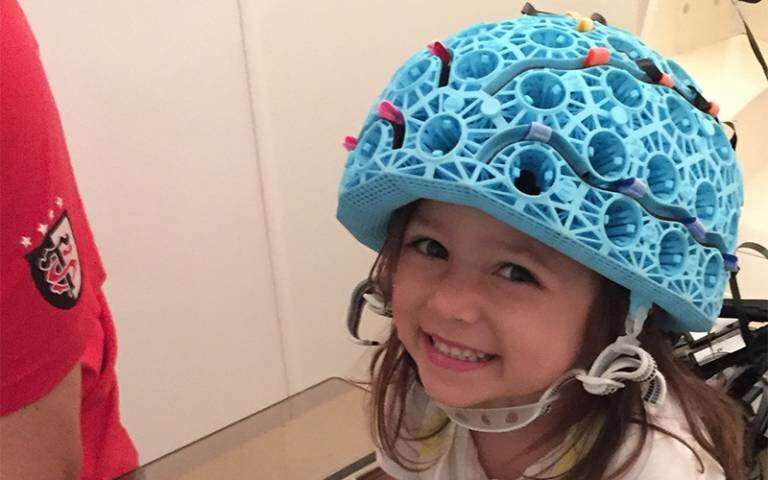
A wearable brain scanner, co-developed by UCL researchers, is now being used in a specialist clinic for children with epilepsy.
The new wearable optically pumped magnetometer magnetoencephalography (OPM-MEG) system, based on technology developed by researchers at UCL and the University of Nottingham, is integrated into a magnetically shielded room at a new diagnostic suite hosted by the Young Epilepsy charity.
Professor Gareth Barnes, who has led the project at the UCL Wellcome Center for Human Neuroimaging, said: “This is the UK’s first MEG brain scanner that will be dedicated to a pediatric clinical population. It is the younger children with epilepsy who benefit the most from early diagnosis and treatment, but these children are traditionally the most difficult to scan. The new system will not only allow us to scan younger children, but the non-invasive brain images it supplies may also help minimize, or entirely remove, some invasive surgical procedures.”
Magnetoencephalography (MEG) is a diagnostic tool which measures the changes in magnetic field generated by neuronal activity in the brain. This activity occurs naturally and the whole scan is completely non-invasive. An MEG study is recognized as one of the most advanced methods of recording and evaluating brain function and its use in epilepsy is well established. However, traditional MEG scanners are optimized for adults and are of limited use in children. Moreover, conventional MEG technology requires a child to stay completely still for long periods, or even be sedated during the scan.
OPM-MEG makes the scan far more accessible for children, especially those with complex health conditions, as it allows them to wear a helmet, move about within the magnetically shielded room and undertake activities whilst the scan happens. The helmet is adaptable to fit a child of any age. In addition, the new scanner offers higher sensitivity and spatial accuracy compared to the current ones.
The development offers clinicians a far better chance of capturing the rich data necessary to inform their decisions on the best possible treatment pathway for children with complex neurological conditions.
Rosemarie Pardington, Director of Integrated Care at Young Epilepsy explained: “At Young Epilepsy, we are always mindful that each and every child is different. The way their epilepsy affects them will be unique, and personal to them. Having a facility like the MEG is going to make an absolutely massive difference to the children and their families.
“The wonderful thing is that clinicians already recognize MEG as a reliable tool on which to base difficult decisions, such as surgery options, due to the richness and the reliability of the data. This takes it to a wearable form and makes it all a much easier experience for children.”
15 year old Samuel is a pupil at the Young Epilepsy St Piers College in Lingfield, who was first diagnosed with epilepsy when he turned four years old. His mum, Tracy, described the traumatic process of getting the diagnosis: “Eventually, the epilepsy diagnosis was confirmed by an EEG on Sam’s fourth birthday and I have to say our first EEG was the most horrific experience. At that point Samuel was very unsettled in his behavior, so in order to get him to sit with wires on his head without moving, we both had to keep pinning him down on my lap. We could only last for twenty minutes instead of an hour.”
Currently, even the best centers that offer epilepsy testing are still hospital environments, where the patient has to stay still on a hospital bed and have electrodes attached directly to their head. Tracy welcomed the change that the new MEG will bring to the process: “With the new MEG it is going to be more of a family friendly environment, where you can bring your favorite toys and your siblings along.”
Conventional MEG recordings are made inside a magnetically shielded room, which suppresses environmental magnetic noise. Rooms built for current MEG systems are very large and require multiple layers of expensive metal alloy for the shielding. In addition, conventional MEG systems rely on magnetic field detectors which must be cooled to -269°C in order to operate.
OPM-MEG uses a different type of sensor—optically pumped magnetometers (OPMs), which don’t need cooling to work. In the new system the patient wears a comfortable helmet with sensors attached, meaning that the sensors are closer to the scalp.
Source: Read Full Article
